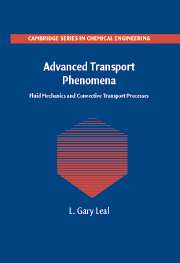Book contents
- Frontmatter
- Contents
- Preface
- Acknowledgments
- 1 A Preview
- 2 Basic Principles
- 3 Unidirectional and One-Dimensional Flow and Heat Transfer Problems
- 4 An Introduction to Asymptotic Approximations
- 5 The Thin-Gap Approximation – Lubrication Problems
- 6 The Thin-Gap Approximation – Films with a Free Surface
- 7 Creeping Flow – Two-Dimensional and Axisymmetric Problems
- 8 Creeping Flow – Three-Dimensional Problems
- 9 Convection Effects in Low-Reynolds-Number Flows
- 10 Laminar Boundary-Layer Theory
- 11 Heat and Mass Transfer at Large Reynolds Number
- 12 Hydrodynamic Stability
- Appendix A Governing Equations and Vector Operations in Cartesian, Cylindrical, and Spherical Coordinate Systems
- Appendix B Cartesian Component Notation
- Index
10 - Laminar Boundary-Layer Theory
Published online by Cambridge University Press: 05 June 2012
- Frontmatter
- Contents
- Preface
- Acknowledgments
- 1 A Preview
- 2 Basic Principles
- 3 Unidirectional and One-Dimensional Flow and Heat Transfer Problems
- 4 An Introduction to Asymptotic Approximations
- 5 The Thin-Gap Approximation – Lubrication Problems
- 6 The Thin-Gap Approximation – Films with a Free Surface
- 7 Creeping Flow – Two-Dimensional and Axisymmetric Problems
- 8 Creeping Flow – Three-Dimensional Problems
- 9 Convection Effects in Low-Reynolds-Number Flows
- 10 Laminar Boundary-Layer Theory
- 11 Heat and Mass Transfer at Large Reynolds Number
- 12 Hydrodynamic Stability
- Appendix A Governing Equations and Vector Operations in Cartesian, Cylindrical, and Spherical Coordinate Systems
- Appendix B Cartesian Component Notation
- Index
Summary
In Chap. 9 we considered strong-convection effects in heat (or mass) transfer problems at low Reynolds numbers. The most important findings were the existence of a thermal boundary layer for open-streamline flows at high Peclet numbers and the fundamental distinction between open- and closed-streamline flows for heat or mass transfer processes at high Peclet numbers. An important conclusion in each of these cases is that conduction (or diffusion) plays a critical role in the transport process, even though Pe → ∞. In open-streamline flows, this occurs because the temperature field develops increasingly large gradients near the body surface as Pe → ∞. For closed-streamline flows, on the other hand, the temperature gradients are O(1) – except possibly during some initial transient period – and conduction is important because it has an indefinite time to act.
In this chapter we continue the development of these ideas by considering their application to the approximate solution of fluid mechanics problems in the asymptotic limit Re → ∞, with a particular emphasis on problems in which boundary layers play a key role. Before embarking on this program, however, it is useful to highlight the expected goals and limitations of the analysis in which we formally require Re → ∞ but still assume that the flow remains laminar. In practice, of course, most flows will become unstable at a large, but finite, value of Reynolds number and eventually undergo a transition to turbulence, and this is the flow we will see in the lab.
Information
- Type
- Chapter
- Information
- Advanced Transport PhenomenaFluid Mechanics and Convective Transport Processes, pp. 697 - 766Publisher: Cambridge University PressPrint publication year: 2007
